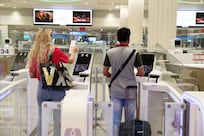The Middle East's cruise sector is lagging behind global competitors as it seeks to navigate the challenging waters of the Red Sea crisis, but industry experts said the region still has major potential for growth.
Major cruise operators have adjusted itineraries or cancelled voyages amid attacks by Yemen's Houthi rebels on commercial vessels in the key shipping route.
Dave Goodger, managing director of EMEA Tourism Economics, an Oxford Economics company, said deployment to the Red Sea is down on last year and occupancy is a bit lower, but that the industry was “very resilient”.
“There is this perception of risk and [tourism is] driven by perceptions,” Mr Goodger said during a panel discussion at the Arabian Travel Market exhibition in Dubai, which ends on Thursday.
“When there are adverse effects, people tend to stay away, but travellers come back.
“There is an impact today, but that's not to say it'll impact the industry tomorrow.”
'We are very confident'
While cruise travel is outpacing wider demand for international travel around the world, with the exception of Asia, the Middle East's recovery is slower, according to Tourism Economics's latest report.
Whereas cruise occupancy is at 111 per cent in the Caribbean, for example, and 107 per cent in the Mediterranean, it's at 90 per cent in the Middle East and Africa, it found.

The longer-run potential is clear for the region, however, once safe passage through the Suez Canal is possible, the report added.
Turky Kari, executive director of marketing and corporate communications at Saudi Arabia's Aroya Cruises, said once its first ship sets sail in December, it will go through the Red Sea.
“We are very confident and all Red Sea authorities and the Saudi government support this 100 per cent,” he said.
Aroya comes under the management of Saudi Arabia's Public Investment Fund’s cruise company, Cruise Saudi. It plans to launch three cruise ships within 10 years, as well as add seven new ports by 2030 and reach 1.3 million passengers per year.
Its first cruises will last three nights, departing from Jeddah and then spending a day at sea followed by a private island along the Red Sea coast. A seven-night cruise will follow in January, taking in Jeddah, Ain Sokhna and Sharm El Sheikh in Egypt, and Aqaba, Jordan. Aroya also has plans to cruise across the Gulf and the Mediterranean.
A stronger GCC cruise sector
The potential within the region's cruise sector is “huge”, said Saud Hareb Almheiri, cruise tourism and yachting lead at Dubai Department of Economy and Tourism. “But people in the region need to be more aware that they can cruise in our own backyard. They don't need to fly six hours to the Med or 15 hours to the Caribbean.”
This is why Cruise Arabian Alliance was set up in March, to foster co-operation in the region as the countries work together to maintain service levels and educate the market.
“We're strong, but we're stronger together,” said Mr Almheiri.

Lakshmi Durai, chief executive of Middle East cruise agency CruiseExplore, said the more cruise liners there are in the region, the better for the sector. “One cruise line is not competitive to another cruise line,” she said. “There is a huge number of people who take land vacations every year from here. Instead of a staycation, why not a cruisecation?
“Cruises are very easy to sell. They're all inclusive, it's one vacation to see multiple locations, there are no flight costs. Cruising in the Gulf is a fantastic winter vacation.”
Partnerships and packages are key
Opportunities extend beyond regular holidays, added Mr Kari, who said Cruise Saudi is also looking at developing wedding packages.
Mr Almheiri believes events at sea is another area for growth. “The awareness is not there at the moment, but I believe strongly it'll happen in the near future,” he said. “Holding events at sea will be something different, maybe for smaller cruise ships rather than the larger ships.”
International cruise liners have also shown interest in extending the season through the summer, added Mr Almheiri.
Mr Goodger's findings showed greater demand for longer cruises, but also strong demand for shorter cruises. “The key is to offer a lot of different packages to cater to different ways people can travel,” he said.
“People also spend a night in a destination before or after they cruise, so land tourism can complement, destination benefits can support the port destination by having that infrastructure.”
Partnerships are key, agreed Mr Almheiri. “There has been more happening in this ecosystem in the past year and a half spurred by demand and raised interest,” he said.
This includes Emirates' new two-year partnership with MSC Cruises, which allows passengers to book fly-cruise holiday packages that include return flights from 21 airports across Europe and South America. The agreement was made on Wednesday at Arabian Travel Market.
Ultimately, the future of the industry is bright, Mr Goodger said. “There are two words I use in general when focusing on travel as a whole, with a lot of economic disruptions, and that's cautious optimism,” he said. “But when talking about cruising, it's optimism.”





